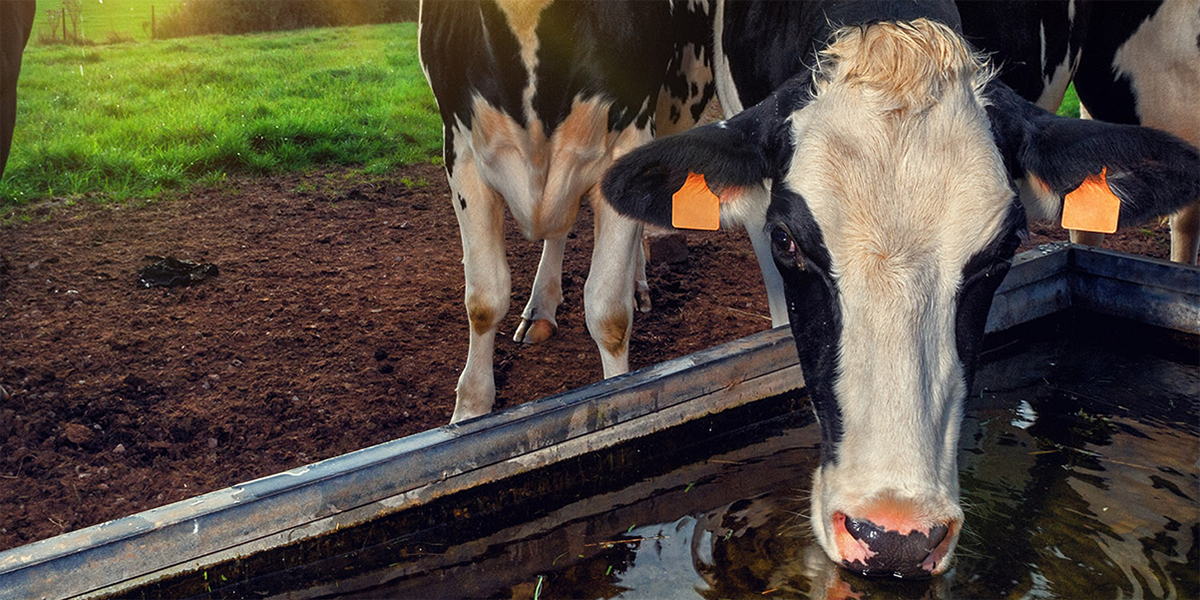Good drinking water is critical to a dairy herd. Each cow consumes 30 to 50 gallons of water (115 to 190 liters) per day — and water accounts for 87% of the milk she produces — so providing clean, safe water is critical to a complete dairy cattle nutrition plan for maximizing performance.
Use the guidelines below to help ensure adequate water quality for your dairy herd.
In the fall, very wet conditions can drastically change the water composition at a given location due to soil run-off, contamination, etc. This increase of water coming into water sources means water should be tested to ensure there is no increase in contaminants. We recommend testing water every six months (spring and fall are best) to help deal with the variability associated with the seasons. Ultimately, we can’t fix what we don’t know is present.
Water quality and availability are equally important during the winter. Here are some general guidelines for how to handle water during the colder months (especially important for the Midwest, Northeast and Pacific Northwest):
Prior to Cold Weather in Existing Facilities
- Check that all heated waterers are functioning properly.
- Ensure water flow to all waterers is adequate.
- Check insulation on insulated water pipes and replace if they’re in poor condition.
- Protect waterers and water pipes from the elements during cold weather using insulation, straw or other materials.
During Cold Weather in New or Existing Facilities
- Check waterers routinely to ensure water flow is adequate.
- Keep pens fully stocked to increase water flow.
- Waterers and surrounding surfaces should be cleaned of ice, snow and mud frequently.
- During extreme cold spells, remove ice accumulations routinely. Options include:
- Sprinkling the floor around the waterer with potassium chloride daily. A word of caution: This may slightly roughen the concrete over several years.
- Use high-pressure steam cleaners to remove accumulated ice and frozen manure.
- In pens with multiple waterers, consider shutting off the water supply to a portion of the waterers to increase water flow through the remaining waterers. Drain the pipes supplying water to inactive waterers.
- If automated water systems with heating units are used, check them often. Also, observe units closely for malfunction or stray voltage.
- Water for calves should be at or near normal body temperature (101.5º F).
- Have a plan in place for auxiliary water supplies in the event of an emergency water outage.
Water Quality Is Critical for Dairy Cattle Nutrition
Ultimately, it’s important to check water quality regardless of season, but it becomes even more important during this time of the year when composition changes are much more common and adverse weather conditions can make water supplies limited. In general, be sure to pay attention to the water quality for your dairy herd for the following reasons:
- Following air, water is the nutrient required in the highest quantity for cattle.
- Dairy cows spend four to five hours per day eating, but only 20 to 30 minutes drinking.
- Dairy cows require adequate amounts of water to function on a basic level.
- Poor quality water/low water intake impacts cow health and limits the benefits of trace minerals.
- Drinking water provides 60% to 80% of a lactating cow’s daily water intake.
- Dissolved solids in water impact cow performance.
- The impacts of poor water quality are vast and far-reaching.
- Calves need good water to thrive, as it’s the majority of their diet.
Water Quality Improves Nutrient Intake
The challenge affecting dairy cows and young stock basically comes down to water being either inaccessible or polluted with high levels of contaminants — both of which result in decreased water intake, which can negatively impact health and performance. High levels of contaminants also impact the nutrients an animal gets from their diet. Therefore, the diet put in front of the cow may not be utilized well due to what’s in the water (e.g., high iron in water can tie up and limit the benefits of trace minerals).
Variable conditions, like heavy rainfall, can make issues like this worse. This is why regular testing of water is critical. When it comes to water testing — how often it should be done and how to get more accurate results — use the guidelines set out in our Providing Clean Water Improves Dairy Cattle Nutrition and Production article. It also provides some effective ways to resolve common issues from inadequate dairy cattle nutrition plans.

